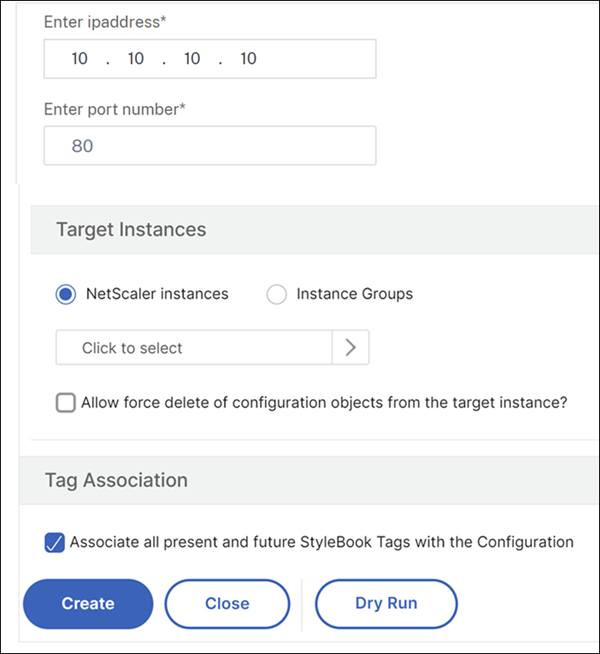-
-
Importing and synchronizing StyleBooks from an external repository
-
Create and use custom StyleBooks
-
Create a StyleBook to upload files to NetScaler Console service
-
Create a StyleBook to upload SSL certificate and certificate key files to NetScaler Console service
-
Enable analytics and configure alarms on a virtual server defined in a StyleBook
-
Allow special characters with their literal form in StyleBooks
-
-
Use target NetScaler instances as data sources
-
Use API to create configurations from StyleBooks
-
This content has been machine translated dynamically.
Dieser Inhalt ist eine maschinelle Übersetzung, die dynamisch erstellt wurde. (Haftungsausschluss)
Cet article a été traduit automatiquement de manière dynamique. (Clause de non responsabilité)
Este artículo lo ha traducido una máquina de forma dinámica. (Aviso legal)
此内容已经过机器动态翻译。 放弃
このコンテンツは動的に機械翻訳されています。免責事項
이 콘텐츠는 동적으로 기계 번역되었습니다. 책임 부인
Este texto foi traduzido automaticamente. (Aviso legal)
Questo contenuto è stato tradotto dinamicamente con traduzione automatica.(Esclusione di responsabilità))
This article has been machine translated.
Dieser Artikel wurde maschinell übersetzt. (Haftungsausschluss)
Ce article a été traduit automatiquement. (Clause de non responsabilité)
Este artículo ha sido traducido automáticamente. (Aviso legal)
この記事は機械翻訳されています.免責事項
이 기사는 기계 번역되었습니다.책임 부인
Este artigo foi traduzido automaticamente.(Aviso legal)
这篇文章已经过机器翻译.放弃
Questo articolo è stato tradotto automaticamente.(Esclusione di responsabilità))
Translation failed!
Use target NetScaler instances as data sources
You can also use the target NetScaler of your configuration itself as a data source input for your configuration. In this scenario, you might want to refer the existing configuration on the target NetScaler to create new configurations on that NetScaler.
To use target instances as data sources, you don’t have to use the datum built-in type parameter, since no NetScaler instances need to be selected by the StyleBook user. You can directly write expressions in the components section of your StyleBook that retrieve data from the target NetScaler instance.
Use the following expression to retrieve the following from the target NetScaler instances:
-
Collections:
$current-target-as-datasource.collections.<collection-name> <!--NeedCopy-->Example:
$current-target-as-datasource.collections.lbvserver <!--NeedCopy--> -
Attributes:
$current-target-as-datasource.collections.attributes.<attribute> <!--NeedCopy-->
Example StyleBook to use the target NetScaler instance as a data source
The following is an example StyleBook to demonstrate how to use the target NetScaler instance as a data source:
---
name: lb-add-service-with-target-adc
namespace: com.citrix.adc.stylebooks
version: "1.1"
display-name: "HTTP/SSL LoadBalancing StyleBook with Service Binding"
description: "This stylebook defines a typical Load Balanced Application configuration."
schema-version: "1.0"
import-stylebooks:
-
namespace: netscaler.nitro.config
prefix: ns
version: "10.5"
components:
-
name: servicegroup-comp
type: ns::servicegroup
properties:
servicegroupname: "lb-demo-svcgrp"
servicetype: "HTTP"
components:
-
name: lbvserver-svg-binding
type: ns::lbvserver_servicegroup_binding
repeat: $current-target-as-datasource.collections.lbvserver
repeat-item: lbvsrvr
repeat-condition: $lbvsrvr.attributes.name == "lb-demo-lb"
properties:
name: $lbvsrvr.attributes.name
servicegroupname: $parent.properties.servicegroupname
<!--NeedCopy-->
In this example, the configuration pack checks for the load-balancing virtual servers in the target NetScaler instances. And, if the given load-balancing virtual server IP address is matched, it retrieves the name and service group name.

Share
Share
This Preview product documentation is Cloud Software Group Confidential.
You agree to hold this documentation confidential pursuant to the terms of your Cloud Software Group Beta/Tech Preview Agreement.
The development, release and timing of any features or functionality described in the Preview documentation remains at our sole discretion and are subject to change without notice or consultation.
The documentation is for informational purposes only and is not a commitment, promise or legal obligation to deliver any material, code or functionality and should not be relied upon in making Cloud Software Group product purchase decisions.
If you do not agree, select I DO NOT AGREE to exit.